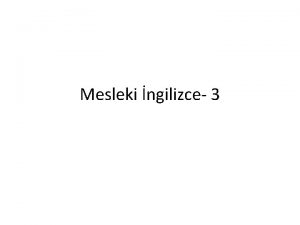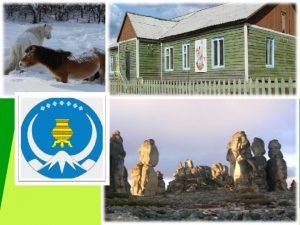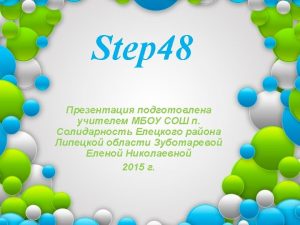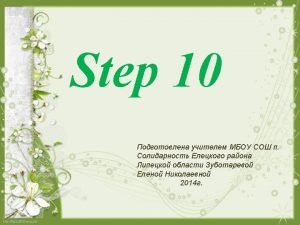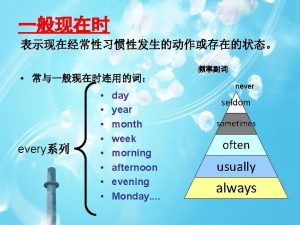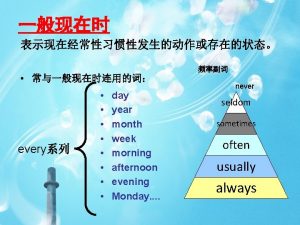Good Morning Good Afternoon Good Evening Good Night






























- Slides: 30

Good Morning! Good Afternoon! Good Evening! Good Night! Good Late Night! Good early Morning! (-2 to +15)

Thank you for joining us for the 22 th Week (year 37 of the (HT)Condor project) (year 15 of the CHTC)

11/2020

“The Contributions of the Condor system to Distributed and High Throughput Computing is the result of the ingenuity, imagination, commitment and hard work of many individuals. I am standing here to receive this award as a representative of this special group of researchers, developers and students. These contributions are also due to the researchers who trusted us and adopted Condor to serve their high throughput computational needs. Their guidance and feedback have been invaluable in getting us to where we are today in terms of understanding distributed systems and High throughput computing technologies. ”




Oracle Case Study – Implementation Timeline 4 4 1998 -2002 þ Validation of existing products þ Solution Validation 4 Working Prototype 2002 -Present þ Founded Optena 4 Mission is to provide Scalable, Manageable High Throughput Computing Solutions 4 Partnered with UW to get a source license of Condor in order to build a complete solution 4 Plan was to build additional capability into Condor and around it þ Deployed to Oracle 4 Initial 400 node production Grid Dec 2003 4 Grew to 3000+ node Grid by Apr 2004 4 Running on Windows, Linux and Solaris 8

A Partnership Launched! On October 1, 2020 we started the 5 years, $4. 5 M annual budget NSF “Partnership for Advanced Throughput Computing (PATh)” project “The Partnership to Advance Throughput Computing (PATh) project will expand Distributed High Throughput Computing (d. HTC) technologies and methodologies through innovation, translational effort, and large-scale adoption to advance the Science & Engineering goals of the broader community. ” Aligned with NSF Cyberinfrastructure blueprint


An organic partnership – Partnership between the UW-Madison CHTC and the OSG Consortium – Builds on decades of collaboration, common vision and shared principals – Two main elements of PATh are the HTCondor Software Suite (HTCSS) and the Fabric of Capacity Services (Fo. Ca. S) offered by the OSG – Involves 40 individuals at seven institutions – Committed to community building (HTCondor Week(s) and the OSG school)

• Strong ties to the OSG Executive Team • OSG Council serves as Advisory Board • Cooperative Agreement with the NSF

The UW-Madison Center for High Throughput Computing (CHTC) was established in 2006 to bring the power of High Throughput Computing (HTC) to all fields research, and to allow the future of HTC to be shaped by insight from all fields of research

• CHTC is home for the HTCondor Software Suite (HTCSS) • CHTC is operating a HTCondor pool and a SLURM cluster that are open (fair share) to any campus researcher and their collaborators • CHTC is supporting sharing across ~10 campus HTCondor pools (CMS T 2, Ice. Cube, Bio. State, Space. Science, …) • CHTC is providing campus researchers with Research Computing Facilitation services

OSG Consortium • Established in 2005, the OSG is a consortium governed by a council • Consortium Members (Stakeholder) include campuses, research collaborations, software providers and compute, storage, networking providers • The OSG provides a fabric of d. HTC Services to the consortium members and to the broader US Science and Engineering (S&E) community • While members own and operate resources, the consortium does not own or operate any resources • Council elects the OSG Executive Director who appoints an Executive team. Together they steer and manage available effort

OSG Statement of Purpose OSG is a consortium dedicated to the advancement of open science via the practice of distributed High Throughput Computing (d. HTC), and the advancement of its state of the art.

OSG Fabric of Services • Organized under three main thrusts – Community Building, Research Computing Facilitation, and Operation • Designed and operated to assure, scalability, trustworthiness, reproducibility. • OSG claims its services enabled in the past 12 month more than 2 B core hours across more than 130 clusters located at more than 70 sites and more than 200 TB of data cached across 17 caches worldwide.

OSG Compute and Data Federation

How do Cloud Resources fit into the Distributed High Throughput Computing (d. HTC) model of the fabric of Services provided by the Open Science Grid (OSG)?

Naturally! It is all about offering Access Points and services to deploy Execution Points

The Open Science Pool (OSPool) A service provided by the OSG are Access Points (APoint) that are open to any US researcher and a distributed HTCondor pool that is managed under a fair-share scheduling policy – APoint provides workload automation, auditing, and workflow management (DAGMan, Pegasus) capabilities designed to accommodate High Throughput applications in a distributed environment – Data for input sandboxes is staged at the APoint or placed in the OSG data federation – Output sandbox data is staged at the APoint – On 04/20/2021, the OSPool completed ~200 K jobs from 29 projects submitted by 33 users that consumed ~640 K core hours

PATh Executive Summary “Broader Impact – We firmly believe in d. HTC as an accessible computing paradigm which supports the democratization of research computing to include researchers and organizations otherwise underrepresented in the national CI ecosystem. Our work is founded on universal principles like sharing, autonomy, unity of purpose, and mutual trust. ”

11/2001 at Boston University

Democratizing Access In her presentation at the NSFNET 35 th Anniversary NSF CISE AD Margert Martonosi articulated the challenge of Democratizing Access to National Research Computing Resources. We view Access Points as holding the key to addressing this national challenge – OSPool APoints can be deployed and operated by a single PI laboratory or by organizations like campuses and science collaborations – APoints can be used to manage deployment of XPoints – APoints can scale out to accommodate large HTC workloads

Bring Your Own Resources (BYOR) The members of PATh are working on enhancing BYOR services for institutional clusters, HPC systems and commercial cloud resources – Enable users to define, create, manage, and control usage of collections of resources obtained via batch systems, HPC (XRAC) allocations, NSF Cloud. Bank accounts or purchased directly from commercial cloud providers. We refer to such a collection as an personal Annex – Interface with workload and workflow services to manage acquisition of resources (deployment of XPoints) from different providers of computing capacity

How do sites contribute to the OSPool? When a site in the OSG Compute Federation wants to contribute the capacity of a server to the OSPool, it runs an e. Xecution Point (XPoint) on the server – Site can start and stop the XPoint at any time – XPoint needs to establish trust with APoint – OSG provides services to remotely activate XPoints through a Compute Entry. Point (CE) that submits activation requests to the batch system of the cluster – OSG provides services to automate remote activation of XPoints – XPoint prefers to have out going network connectivity

Open. Stack Environment The Jetstream cloud is an Open. Stack, NSF-funded academic cloud operated by the Indiana University and TACC. Operators decide when to start and terminate Virtual Machines (or containers) that run OSPool XPoints. 750 K core hours Core Wall Hours by Project Work with NSF funded Chameleon is progressing nicely

Archimedes of Syracuse was a Greek mathematician, philosopher, scientist and engineer. Give me a place to run an XPoint and I shall run your job. Frank Würthwein is a Physics professor at UCSD and the Executive Director of the OSG

HTCondor d. HTC CI of >51 K GPUs in the Cloud @ SC 19 Ice. Cube Access Point XPoint In VM Negotiator One global HTCondor pool Collector XPoint In VM Collector

Thank you for building such a wonderful and thriving HTC community
 Hello good afternoon google
Hello good afternoon google Good evening students
Good evening students Good afternoon buenas tardes
Good afternoon buenas tardes Good morning afternoon evening
Good morning afternoon evening Good mornig class
Good mornig class Glad to see you anton
Glad to see you anton Goodmorning class
Goodmorning class Good evening teacher
Good evening teacher Morning ladies and gentlemen
Morning ladies and gentlemen Gentlemen good night ladies good morning
Gentlemen good night ladies good morning And the afternoon the evening sleeps so peacefully
And the afternoon the evening sleeps so peacefully Formal morning greetings
Formal morning greetings Rainbow at night sailors delight
Rainbow at night sailors delight Morning bells are ringing morning bells are ringing
Morning bells are ringing morning bells are ringing Morning i see you in the sunrise every morning
Morning i see you in the sunrise every morning Morning night april
Morning night april Teacher:good morning students
Teacher:good morning students Charlotte zone
Charlotte zone Good morning good lookin
Good morning good lookin Xxx good evening
Xxx good evening Good afternoon, students
Good afternoon, students Good afternoon saatleri
Good afternoon saatleri Good afternoon please have a seat
Good afternoon please have a seat Good afternoon stay healthy
Good afternoon stay healthy Good evening, heading
Good evening, heading Receptionist good morning
Receptionist good morning Assalamualaikum good morning
Assalamualaikum good morning Conversation good morning
Conversation good morning Shop assistant good evening what can i do for you
Shop assistant good evening what can i do for you Good afternoon, teacher
Good afternoon, teacher Examples of conversation
Examples of conversation






























